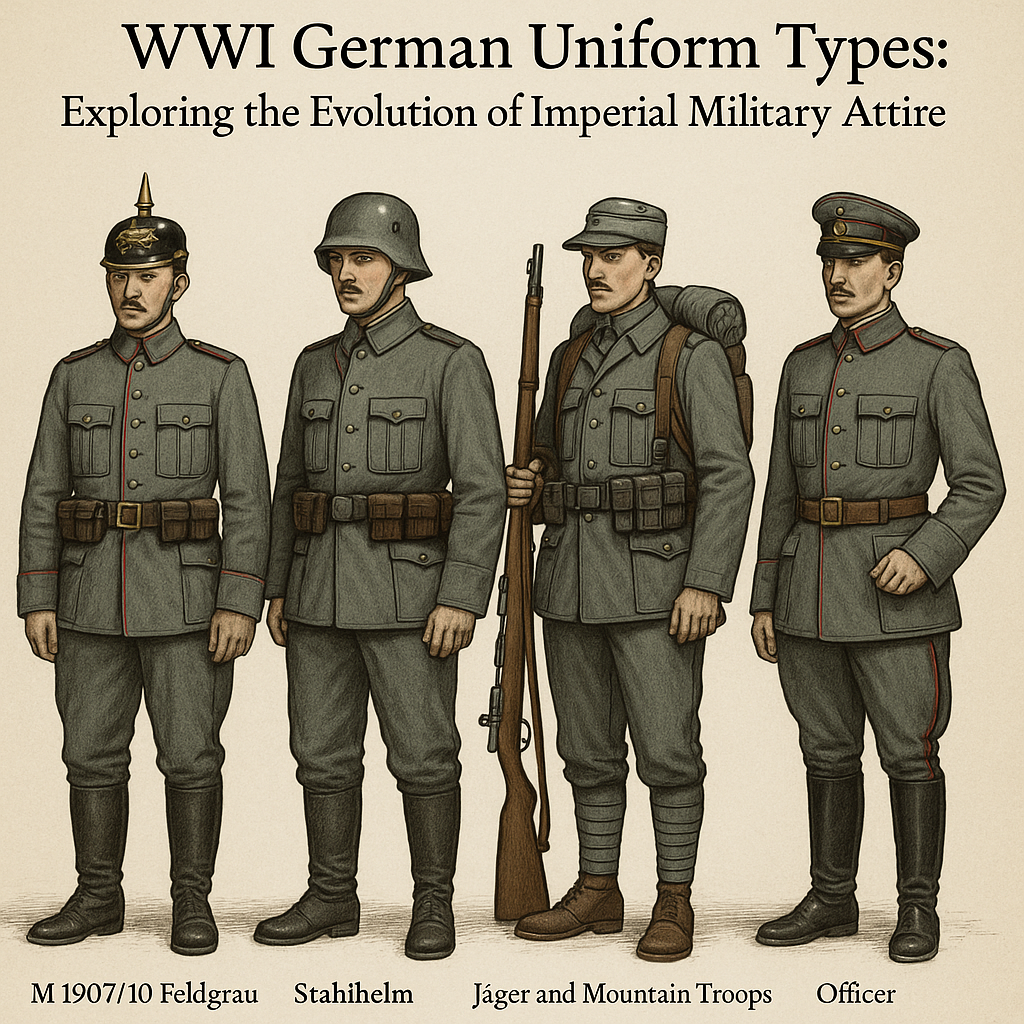
WWI German Uniform Types: Exploring the Evolution of Imperial Military Attire
Published on May 10, 2025
WWI German Uniform Types: A Deep Dive into Imperial Military Attire
When we picture a World War I German soldier, iconic images come to mind—grey wool tunics, spiked helmets, and iron discipline. However, beneath these visual symbols lies a rich history of evolution, functionality, and adaptation. German uniforms in WWI underwent several transitions to meet the demands of trench warfare and technological changes. This article offers a detailed overview of the primary WWI German uniform types, breaking them down by era, role, and significance.
1. The Pre-War Influence and the M1907/10 Feldgrau Tunic
Before World War I erupted in 1914, military uniforms across Europe were still influenced by 19th-century traditions—bright colours, elaborate decorations, and limited focus on camouflage. Germany began moving away from this trend with the introduction of the M1907/10 Feldgrau uniform.
The M1907/10 tunic marked a significant departure from the colourful uniforms of the Franco-Prussian War era. Its field-grey (feldgrau) colour was designed to blend with European landscapes. The tunic featured:
- A stand-and-fall collar
- Pleated chest pockets
- Red piping, which was later removed
- Brass buttons and regimental insignia
Though initially decorative, the tunic laid the foundation for later wartime simplifications.
2. Headgear: From Pickelhaube to Stahlhelm
Pickelhaube – The Iconic Spiked Helmet
At the outbreak of WWI, German soldiers wore the Pickelhaube, a leather helmet with a prominent spike. Though it symbolized prestige and national pride, the Pickelhaube was impractical in trench warfare. It provided minimal protection and was cumbersome in modern combat environments.
The Stahlhelm – Modern Protection
Introduced in 1916, the Stahlhelm revolutionized battlefield headgear. Its steel composition offered superior protection from shrapnel and debris, and its design became symbolic of German troops during the latter half of the war. It eventually replaced the Pickelhaube on nearly all fronts.
3. The Transition to the M1915 Tunic
As the war dragged on, Germany faced material shortages and shifting tactical demands. Uniforms became more utilitarian. The M1915 tunic reflected this change:
- Feldgrau remained the standard colour.
- Red piping and brass buttons were removed to streamline production.
- Detailing was reduced for practicality.
This new design emphasized function over flair, aligning more closely with the reality of trench warfare.
4. Specialized Units and Their Uniform Variations
Not all German soldiers wore the same uniform. Several specialized units had modifications to suit their roles:
Jäger Units (Light Infantry)
Jäger troops operated in difficult terrain and often behind enemy lines. Their uniforms featured:
- More rugged boots
- Shorter, tailored tunics for mobility
- Specific badges and darker shades of feldgrau
Mountain Troops
Mountain or alpine soldiers needed gear suitable for cold, high-altitude environments. Their attire included:
- Reinforced tunics and trousers
- Woollen underlayers
- Protective gaiters
Cavalry and Artillery Units
These troops retained more traditional styles early in the war but later transitioned to simplified designs. Cavalry units often wore riding breeches, and artillerymen carried specific insignia to distinguish their roles.
5. German Officer Uniforms: Prestige and Adaptation
German officers typically wore higher-quality uniforms, often tailored and adorned with fine details to indicate rank and status. Key elements included:
- Silver or gold piping
- Personalized tailoring
- Epaulettes and sleeve rank insignia
Officers also carried sidearms, whistles, and binoculars as standard accessories. However, as trench warfare intensified, many opted for less conspicuous attire to blend in with troops and avoid becoming targets.
6. Rank and Insignia Identification
Uniforms carried crucial information through colours and insignia, helping identify rank, unit, and branch. Common colour codings included:
- White piping for infantry
- Red for artillery
- Blue for engineers
- Yellow for cavalry
Sleeve insignia, shoulder boards, and collar tabs further denoted rank—from enlisted soldiers to generals.
7. Material and Climate Adaptations
Germany’s vast and varying war fronts required different materials for different environments. Winter gear became critical on the Eastern Front, where bitter cold made woollen greatcoats, fur-lined gloves, and balaclavas standard issue.
In contrast, summer gear involved lighter fabrics and removable tunic liners. The necessity of adapting to seasonal changes often led to non-standard combinations of gear on the front.
8. Influence on Later WWII Uniforms
The lessons learned from WWI directly influenced the development of 1940 soldier uniforms used in WWII. Features such as:
- Standardized colour palettes (feldgrau remained dominant)
- More comfortable field tunics
- Durable headgear (the Stahlhelm evolved further)
Also, WWII saw the emergence of specialized camouflage and the notorious Nazi uniforms, especially those worn by SS units. These were more rigid in appearance and heavily symbolic in design, focusing on psychological impact as much as function.
9. Reproduction and Historical Preservation
Today, WWI German uniforms are treasured by collectors, historians, and reenactors. Reproductions allow people to study and engage with history tangibly. Authentic replication requires attention to stitching, material type, and correct insignia—which is important for historical accuracy and educational purposes.
These uniforms help keep the stories of soldiers alive and serve as reminders of how warfare shapes culture, identity, and fashion.
Conclusion
WWI German uniforms encapsulate a critical transitional period in military attire—when traditional design collided with the harsh demands of modern warfare. From the elegant, impractical Pickelhaube to the battle-hardened Stahlhelm, from decorative tunics to streamlined field uniforms, the evolution of German military clothing during WWI tells a story of adaptation, resilience, and identity.
Understanding these uniforms isn't just about fabric and buttons—it's about the soldiers who wore them and the roles they played in a defining moment of the 20th century.
